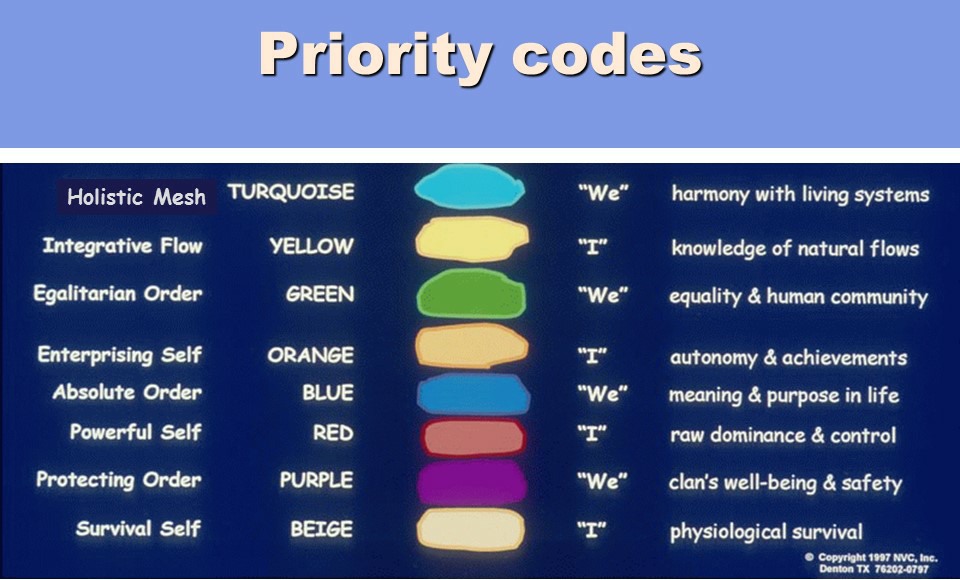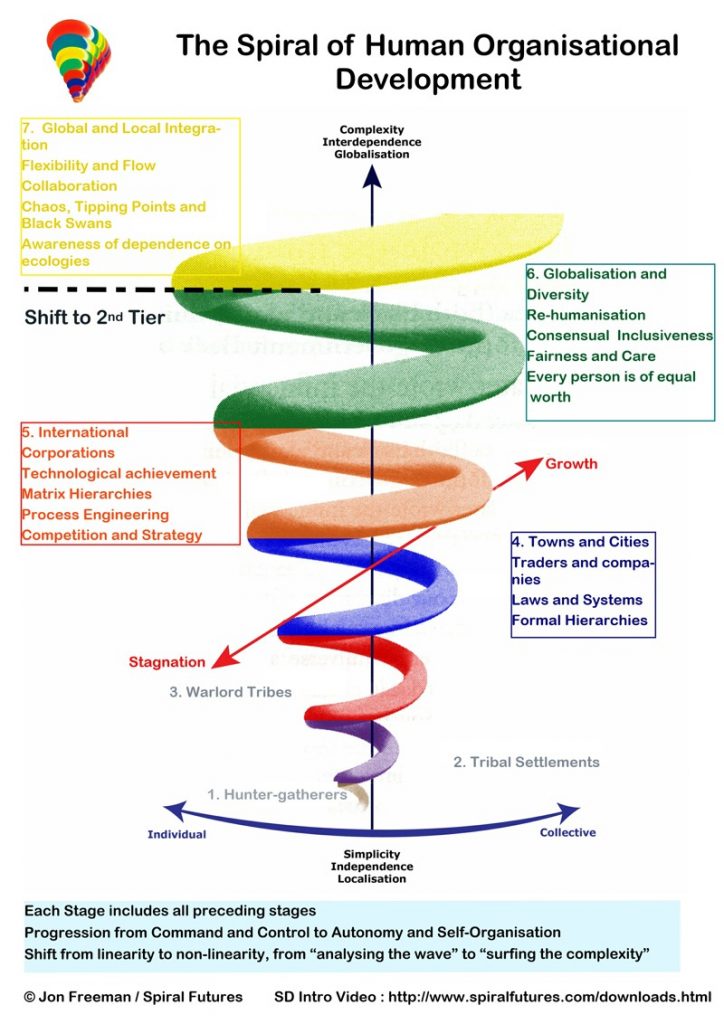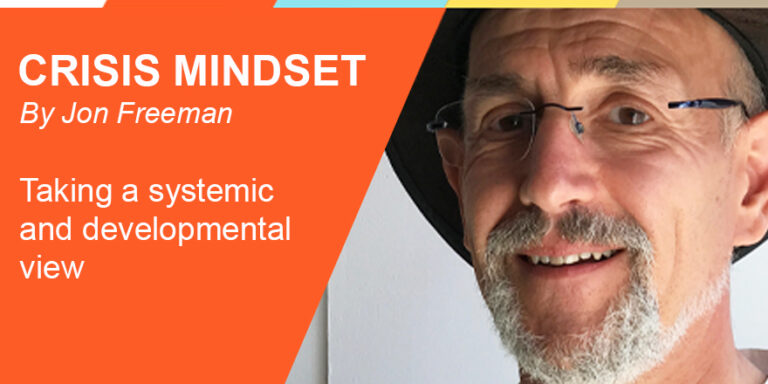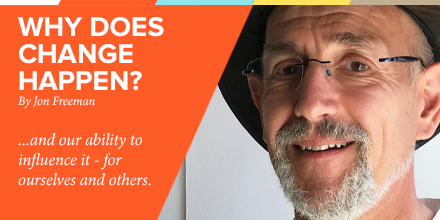Spiral Dynamics: navigation for our turbulent times
Are you sitting comfortably? Few of us are, I suspect. It is hard to look at the world without concern. Perhaps you are concerned about the volatile leadership of Trump, or the rise of the right in Europe or perhaps the unpredictability of what Brexit will bring for both the UK and beyond. Do you sense a world that is out of control?
Would it surprise you to hear that spiral dynamics predicted these conditions over 40 years ago? What if the world is doing just what could have been expected if we knew more about how and why it changes? Would you want to know the rules of the game? Would you want to know how they affect big societal changes, organisational function and personal development alike? This story is about what we can do in the face of this turbulent world.
Patterns we can influence
Humans are pattern-sensing and meaning-making creatures. This capacity is part of our evolutionary advantage. I want to talk about a very big pattern, one that resembles Darwin’s insight into biological evolution. But while Darwin explains evolution, we can’t influence it much. This pattern is different because it describes something that we CAN influence – the progress of humanity at every level. There is considerable power in this; that we can not only explain, we can also predict, diagnose and affect what happens
The theory known as “Spiral Dynamics” delivers this.
 It tells us that human thinking changes in order to adapt to the conditions we live in. We adopt different priorities.
It tells us that human thinking changes in order to adapt to the conditions we live in. We adopt different priorities.
Take for instance a young, startup organisation.
Early on, its priority is to develop some potency and power in the marketplace. This means doing whatever it takes, changing plans daily, finding and satisfying customers and inventing new ways. This will often be led by a driven individual whose latest wish is the employee’s command. However as the startup gets more established and grows in scale, such chaos becomes dysfunctional. New priorities emerge and the need for some order and process is necessary f you are to be reliable and deliver consistent quality. The boss is still boss, but even he disrespects the system at some peril.
An Organisation’s Developmental Story
There are several other stages an organisation goes through and as each new stage arrives, the others remain as inner voices that must be maintained and accommodated. There are swings and tensions which are discernable flows in the organisational being like a heart-beat, a breathing rhythm and a digestive cycle. Every organisation has a version of this developmental story.
The Spiral Dynamics theory describes the adaptive swings between human impulses to act as individuals, and our desire to form collectives. The patterns are dynamic. It reveals in some detail how the relationship between our world and our adaptive thinking systems works in practice. This makes visible the levers that we can work with, external as well as internal. It is like an MRI scan, x-ray machine and ECG for societal and organisational life. The living metaphor is appropriate, because the system doesn’t stop changing. With more people on the Earth than ever before, doing everything faster through technology and more connectedly through communications, we face new conditions all the time.
A New Level of Thinking
Professor Clare W Graves, who developed spiral dynamics in the 1960’s made the prediction that there would come a point that calls for a bigger step-up than ever – a “momentous leap” for humanity. Now, as he foresaw, there are more stages present and active, compounded by speed of activity and functional complexity and with some challenges, like climate and resources demanding urgent responses. In accordance with Einstein’s often-quoted statement that you cannot solve problems using the same thinking that created them, a new level of thinking is required in order to find simplicity beyond the complexity.
 Regular readers of Future Considerations newsletters will probably have encountered Frederic Laloux and the “teal” approach to organisational change. The stages that he describes in his book originated in Clare Graves’ theory. Laloux had another story to tell. It was not his purpose to describe why the stages are as they are, or how changes happen. But if you lead, or are in, or work with an organisation, knowing how and why the stages are as they are, turns an ECG from meaningless squiggles into usable data. It tells you where the hot-spots are, what is most ready for change, and who is likely to be the best to lead it. Cometh the time, cometh the technology.
Regular readers of Future Considerations newsletters will probably have encountered Frederic Laloux and the “teal” approach to organisational change. The stages that he describes in his book originated in Clare Graves’ theory. Laloux had another story to tell. It was not his purpose to describe why the stages are as they are, or how changes happen. But if you lead, or are in, or work with an organisation, knowing how and why the stages are as they are, turns an ECG from meaningless squiggles into usable data. It tells you where the hot-spots are, what is most ready for change, and who is likely to be the best to lead it. Cometh the time, cometh the technology.
Spiral dynamics, the theory that Clare Graves gave to us 40 years ago is as sound as ever. In a time where not much lasts for long, its continued accuracy is a sign of its brilliance. However, it has expanded through application and through assimilating 40 years of new data. For a few decades, Spiral Dynamics has been mostly an intellectual curiosity, often misrepresented and dumbed down, but adored by a few who have seen what it makes possible. Now it is gaining more attention because its time has come. The “teal” movement is evidence of that. We need the understanding that it brings and the applications that it provides.
If you are a leader, a member of an in-house development team or a change facilitator, it will deliver many new insights and access to new tools. Two thirds of culture change programs are known to fail. If you are a supporting a merger or a cultural alignment / change program, you will see new ways of delivery that will avoid many of the typical pitfalls.
The theory has implications for personal development too and is also of value to coaches. Organisationally it applies to businesses, social enterprises, NFP’s and public sector “municipal entrepreneurs” alike. Whatever you are concerned about, it will help you understand and adapt.
Together with Rachel Castagne and with the support of Future Considerations, I offer a three-day Spiral Dynamics Fundamentals certification course in London. You will be trained on the deeper theory, experience and practice of SDi and at the end of the 3 days, receive a Level 1 practitioner certification. The three days promises to be theoretical, practical and embodied.
You can see further details here. I hope that you will be as inspired to come as we are to teach.
Photo credit Dr Don Beck





Leave a Reply